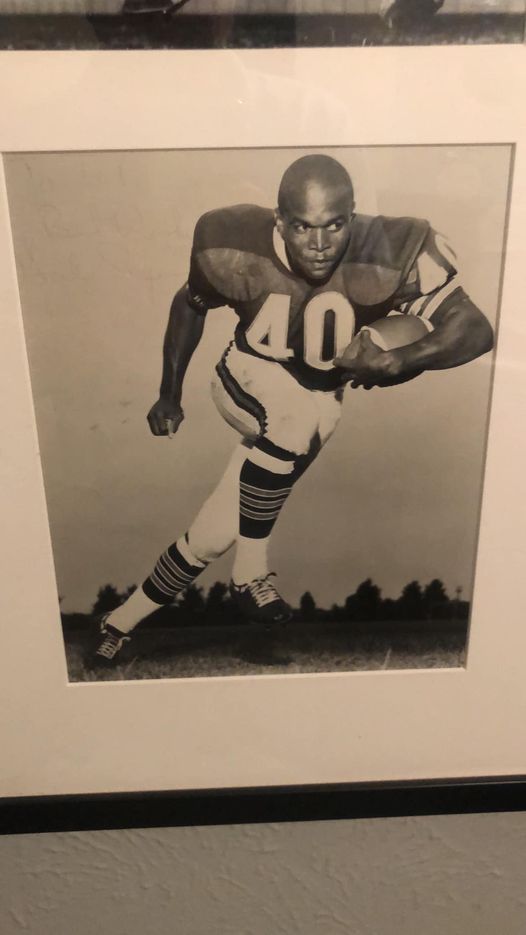By David Mullen
Chicago Bears running back and kick returner Gale Sayers turned the gritty, bloody and hard-nosed game of professional football into an artform. When he was on the field wearing his trademark No. 40 jersey, time stood still.
Nicknamed the “Kansas Comet,” Sayers was born in Wichita, starred at the University of Kansas and transformed a methodical game built on brute strength into a gridiron ballet. Off the field, he broke all convention showing compassion and heart.

As I was discovering pro football in my youth, televised games were limited, and coverage in general was usually left to the creativity of radio announcers and newspaper sportswriters in the following day’s recaps. No ESPN or NFL Network. No “Monday Night Football” halftime highlights. No endless pre- and postgame shows or up-to-the-second video clips.
Home games were not televised, even when sold out. I lived across San Francisco Bay from the home of the 49ers and had access to road games on TV. San Francisco wasn’t very good, but they had John Brodie, who went to Oakland Technical High School and nearby Stanford University. Plus, the NFL was the “real league” and had teams in all of the big cities.
The upstart AFL had a team named the Oakland Raiders that played right down Hegenberger Road. I either watched road games on TV or attended games because an extra ticket went to the kid closest to the stadium. The league was made up of a wild bunch of football nomads playing an exciting, high scoring game, while the plodding smashmouth game — “three yards and a cloud of dust” — was being played by the NFL. Then came Sayers, and everything changed.
I recall a Sunday morning in late 1965 watching the 49ers play the Bears in a rainstorm at soggy Soldier Field. No doubt anchoring a bowl of Frosted Flakes in front of the black and white TV console from Montgomery Ward, I watched Sayers play the role of magician. He bobbed and weaved. His feet never touched the ground. And he was a rookie!
He scored an NFL record six touchdowns — four by rushing, one on a pass reception and one on an 85-yard punt return — in a 61-20 Chicago victory. He was nothing short of amazing. I was hooked on football for life.
Former NFL tight end Kent Kramer, who played eight seasons with the 49ers, New Orleans Saints, Minnesota Vikings and Philadelphia Eagles, went against Sayers in the 1960s as a special teams player.
“He was poetry in motion,” Kramer said, mirroring the same comment made by legendary Bears head coach George “Papa Bear” Halas in 1977. “He would run that sweep and then he would get to the corner and kick it up. He was unique. He was brilliant. He was very light. I was in on a tackle against him and he was a whisp of a man. We had to hit him in the midsection, but we didn’t hit his shoulders or legs. He was firm, but he was cool.
“He was like a gazelle,” said Kramer, who owns Professional Sports Marketing in McKinney. “When you come up to tackle, you leave your feet and have an aiming point. With him, you had to aim ahead of where your aiming point was.”
It was another football Sunday morning in front of the TV in 1968 when the 49ers were playing the Bears. Sayers had rushed for 205 yards against the Green Bay Packers the week before. San Francisco defensive back Kermit Alexander hit Sayers while he was in midair and shredded multiple ligaments in Sayers’ right knee including his ACL and MCL.
Knee surgery was prehistoric back then compared to today’s state-of-the-art procedures. The Kansas Comet would never be the same and I was crushed. I had lost a hero.
Sayers played in the NFL from just 1965-1971. He won the NFL Rookie of the Year and was a five-time, first team All-Pro. He still holds the NFL all-time record for kickoff returns averaging 30.5 yards per attempt. Despite playing in only 68 games due to knee injuries, he was voted into the Pro Football Hall of Fame on the first ballot at age 34. He is the youngest man ever inducted.
The ABC television network, much like the AFL, was an upstart venture, wallowing in third place in a two major network world. ABC tried every type of programming trying to find viewers that would break away from the standards on CBS and NBC, including the “Tuesday Movie of the Week,” a 90-minute, made-for-television production. One of these mini-movies was the 1971 film called “Brian’s Song,” the story of Sayers’ teammate Brian Piccolo, who succumbed to cancer while playing for the Bears.
In racially sensitive nation, the film chronicled the unlikely, yet unwavering, friendship between black man Sayers (played flawlessly by Billy Dee Williams) and white man Piccolo (which introduced James Caan to America), who seemed to have little in common except for a love of football and each other.
The story was enough to make a grown and young man cry. At my house, they did.
Dallas native Ernie Banks is known as “Mr. Cub.” With all due respect to Chicago football greats Dick Butkus, Walter Payton and coach Halas, Sayers is “Mr. Bear.”
Gale Sayers died from complications caused by dementia on September 23 at 77.
The sports world lost notable, well-loved athletes recently when ace pitcher Tom Seaver and record-breaking base steeler Lou Brock passed away. But Sayers was in a league of his own. Like fine art, the beauty and grace of Sayers will live on forever. He was poetry in motion.
